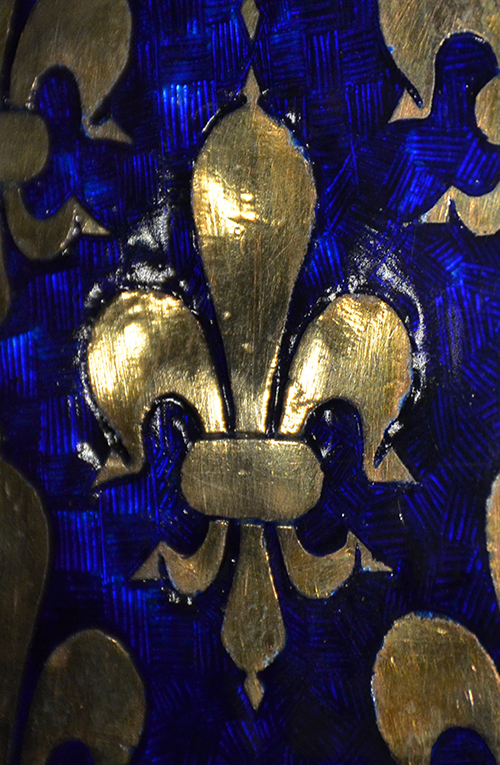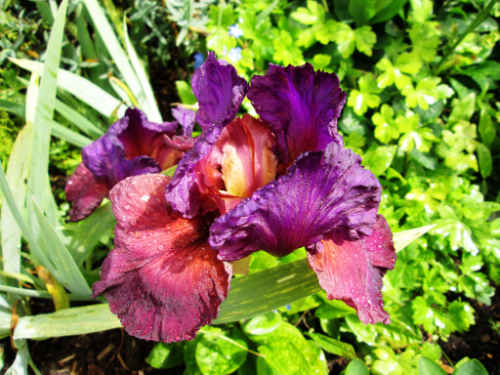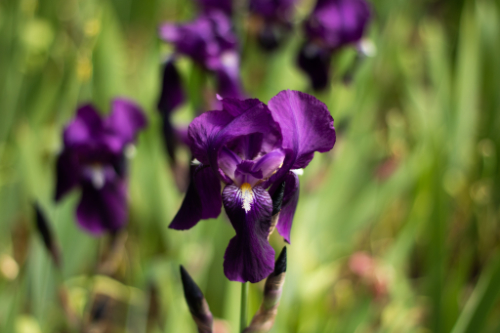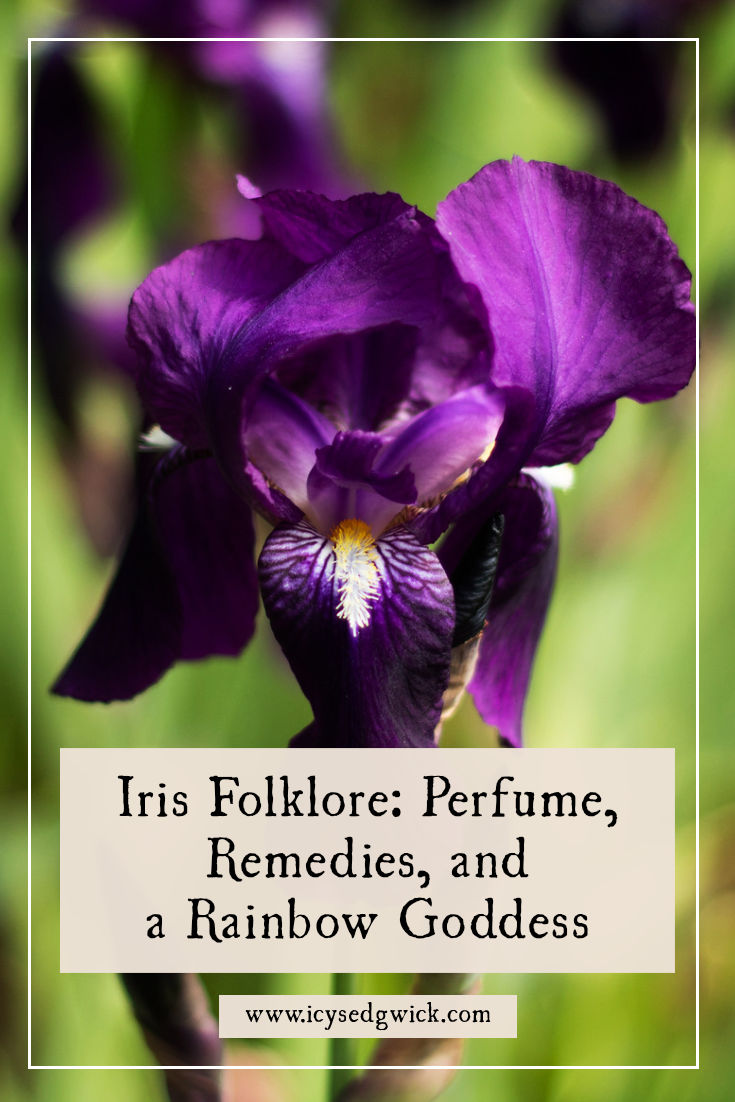Depending on where you are in the world, you might be lucky enough to see the iris bloom before it fades for the year. Where I am, they finished in mid-May, but with the changing climate, that might vary for you.
The iris is one of those instantly recognisable flowers, showy and bright with its voluminous petals, able to add a splash of colour to any garden. They’ve been beloved by humans for millennia, apparently favoured as far back as ancient Egypt as a decorative device.
So how does the iris show up in folklore? We’ll explore that in this week’s article!
Remember though, this post does not constitute medical advice. Where it mentions folk medicine, this is for entertainment purposes only.
The Iris in Greek Myth
Greek myths attribute the iris to Hera, along with the pomegranate, poppy, dittany, and white lily. Miss Carruthers notes that all these flowers were later transferred to the Virgin Mary (1879: 144).
Yet it’s an interesting association between a goddess and a flower given mythology also features Iris herself, the goddess of rainbows. Iris was also a messenger between the gods and humanity, usually depicted as Hera’s personal messenger. It’s perhaps hardly unsurprising that the iris in the Victorian language of flowers meant “a message” (Burke 1867: 31). Though that was probably really unhelpful for someone to send you a message through flowers that tells you it’s a message.
Who was Iris?
Iris bridges the sea and sky, since her father was a sea god, and her mother a cloud nymph. Her sisters were the Harpies. For those who lived at the coast, they thought the goddess transferred sea water into the clouds to create rain (Atsma 2000-2017). She doesn’t have any myths of her own but appears in myths of other gods running errands for them. She appears in the Iliad, but not the Odyssey, which just names Hermes as the messenger god.
Indeed, this is something we see with Iris. She appears in many myths and is instrumental in the battle of Troy, yet nowadays, we only name Hermes as the messenger. Iris is largely forgotten.

While performing her role, Iris didn’t seem to be limited by where she could go. She delivered messages between gods, but also carried advice to humans. When she did so, she often did so in disguise, only occasionally appearing in her full glory to humans. She could even carry messages beneath the sea – something probably made easier with her father’s role as a sea god. And if a god decided to swear an unbreakable oath on the river Styx? Iris went to the underworld to collect some of the Styx’s waters so the oath could be sworn (Kapach 2023).
There’s some debate as to whether Iris personified the rainbow, or used rainbows to get around. Here, she used them like a personal road she could summon when she wanted to travel (Atsma 2000-2017). She also had golden wings, so I think she had a few travel options available to her. Either way, the huge array of colour choices for iris flowers seems to perfectly reflect Iris as a rainbow-associated goddess.
Iris in More Recent Times
Richard Folkard claimed that Iris guided women to the afterlife when they died, as Hermes guided men. As a result, people planted irises on graves as an offering to the goddess to gain her favour (1884: 387). Plenty of 20th-century writers repeat this as apparent fact, though I couldn’t find any references to that in the more scholarly works that drew on ancient Greek sources. If anyone knows of any, please let me know!
As a side issue, scientists named iridium after Iris because it produces colourful salts (Kapach 2023).
The Iris and Folk Medicine
The Iris germanica, or bearded iris, appears across North Africa and Europe. It bloomed along riverbanks in England, and according to Nicolas Culpeper, juice from its roots could ease piles. He also advised making a liquor gargle from the roots to relieve toothache (Dodds 2022: 74).
Margaret Baker picks up this theme, suggesting that rubbing the juice of the yellow iris on a sore tooth will relieve the pain (2011 [1969]: 82). You might have heard of ‘orris root’, which comes from the rhizomes of Iris pallida, or Iris germanica (Lawrence 2020: 200). People chewed on it to freshen their breath after smoking tobacco or eating garlic (Baker 2011 [1969]: 82).
Mildred Fielder also suggested that you could pulverise the roots of Iris versicolor to make a paste, which, when applied, would help to soothe wounds (1975: 24). If you pulverise this rootstock and mixed it with water, you could use it as ear drops for earache (Fielder 1975: 62). Making a tea from the roots apparently treated “lung troubles” (Fielder 1975: 154).
You also needed to pay attention to the root itself before you pulled it up. If an iris root grew upwards, it would pull thorns from flesh. Yet if it grew downwards, it could cure wounds (Folkard 1884: 100).
Other Folklore
Women once stored orris root with their linen to keep away any musty smells (Baker 2011 [1969]: 82). Sometimes people added powdered orris root to their laundry water to help give their linen a pleasing scent (Grieve 1995-2021).
Parfumiers used orris root because it smelled like violets. The ancients also added it to powders for the body and face, and it’s still used in high-end perfumes (Lawrence 2020: 200).
Maud Grieve suggested people could use the juice of the roots to remove freckles – though why you would want to is beyond me (Grieve 1995-2021).
The rhizomes don’t smell when they’re first harvested and it takes anywhere between three and four years before they gain their full aroma. This explains why orris root is so expensive (Lawrence 2020: 200).
In the Scottish Highlands, people used Iris pseudacorus roots to make ink (Squire 2014: 70). This particular iris, or the yellow flag iris, is sometimes called ‘Daggers’, in reference to its sword-shaped leaves (Grieve 1995-2021).
Further afield, people in Iowa used the iris to gauge the weather. One woman in Cedar Falls never swapped her winter underwear for summer underwear until the blue irises blossomed (Baker 2011 [1969]: 82).
Roy Vickery collected a belief from Norfolk that a respondent’s great-grandmother wouldn’t have yellow irises inside the house (2011). Now, it’s not immediately clear why that would be. Whether she had heard of the connection between irises and graves or not, I don’t know. But there are a variety of plants believed to be unlucky if brought indoors, including primroses, hawthorn, and lilac. If anyone knows why a yellow iris shouldn’t be brought inside, let me know!
The Fleur-de-Lys
While the name ‘fleur-de-lys’ translates as ‘lily flower’, some people think it’s actually a stylised iris, not a lily.
According to François R. Velde, the fleur-de-lys dates back as far as Mesopotamia and became linked with royalty during the High Middle Ages. The fleur-de-lys appeared on seals and coins in the 10th century and Philippe II first adopted it as a heraldic motif in the 12th century (1995-98).
The 14th-century explanation saw the plant as a lily to show God blessed the French king, though scholars already disputed it in the 17th century.

Velde points out that the early fleur-de-lys was always yellow, and wild lilies aren’t yellow. The wild iris, Iris pseudacorus, is. This particular plant was called the Lieschblume in German, which was sometimes spelled as ‘leys’ in the Middle Ages. Velde suggests that the fleur-de-lys could refer to this yellow iris as a result (1995-98).
Where did the royal link come from?
There’s also a legend in which Clovis, the first king of the Franks, was heading to fight the king of Aquitania Alaric. But he and his men got stuck trying to cross a river. Eventually, they came across a doe who fled in fright, but she crossed using a ford she knew and reached safety. The men followed her and used the ford. Wild yellow irises grew on the opposite bank, so Clovis put one in his helmet to represent victory. There’s no evidence to suggest any of this happened, but it’s an interesting way to explain the choice of the fleur-de-lys, and also its identity as an iris, not a lily (Velde 1995-98).

This might explain why the three petals of the flower represent wisdom, faith, and valour (Carruthers 1879: 188). Others think the three petals mean prosperity, royalty and valour, or even faith, hope and charity (Lawrence 2020: 200).
Baker suggests an alternative version, in which the yellow irises growing in the river showed Clovis how shallow it was, and where to find the ford (2011 [1969]: 82). Clovis then adopted the iris out of gratitude for its help in showing his army the way to safety.
According to Richard Folkard, in Orleans, people called a seventh consecutive son ‘was known as ‘a Marcon’. People believed he would have a fleur-de-lys marked on his body somewhere. A person with the King’s Evil could cure themselves if they touched this mark, or if the Marcon breathed on them (1884: 341).
The Stinking Iris
Finally, I wanted to end with a very peculiar iris, the Iris foetidissima, or Stinking Gladwyn.
According to Roy Vickery, the plant has little actual folklore, although it does have around 30 local names (2018). This plant is also known as the roast beef plant, or ‘bloody bones’ thanks to its awful smell (Baker 2011 [1969]: 82). It grows under a hedge at the top of my path, and I can confirm, it does smell like beef.
Its vivid orange seeds look a lot like Arum maculatum (Lords-and-ladies) and stinking iris likewise gained an association with snakes. On the Isle of Wight, people call it snake’s fiddles, while in Devon, alternative names include snake’s poison, snake’s food, and snake’s meat (Vickery 2018).
The Pitt Rivers Museum in Oxford has a lover’s knot from Glamorgan made from stinking iris leaves from around 1840. People might use them as offering as wishing wells. Vickery points out that it’s likely someone used the leaves purely because they lent themselves to the task, rather than stinking iris being a specific choice for such an offering (2018).
So what do we make of iris folklore?
Something that fascinated me while I researched this post was the relative lack of folklore. The iris appears for its uses, whether that’s in medicine, cosmetics, or around the home. Very useful plants often have a lot of folklore, reflecting how useful they are – look at nettles – but here, the uses remain and the lore doesn’t.
That might be because the iris is so easy to identify, that it doesn’t need as much folklore. Or perhaps its involvement in the fleur-de-lys overshadows any other legends featuring the plant. Even the links with Iris the goddess are more about the links between the rainbow and the different coloured irises available, and less about the goddess herself.
Either way, it’s a beautiful plant that’s well worth having in your garden, although I’d understand it if you gave stinking iris a miss!
Do you have a favourite colour iris?
References
Atsma, Aaron J. (2000-2017), ‘Iris’, Theoi Project, https://www.theoi.com/Pontios/Iris.html.
Baker, Margaret (2011 [1969]), Discovering the Folklore of Plants, 3rd edition, Oxford: Shire Classics (aff link).
Burke, L (1867), The illustrated language of flowers, London: G. Routledge & Sons.
Dodds, Liz (2022), The Secret Language of Flowers, London: DK.
Editors of Encyclopaedia Britannica (2017), ‘fleur-de-lis’, Encyclopedia Britannica, https://www.britannica.com/topic/fleur-de-lis.
Fielder, Mildred (1975), Plant Medicine and Folklore, New York: Winchester Press.
Folkard, Richard (1884), Plant lore, legends, and lyrics: Embracing the myths, traditions, superstitions, and folk-lore of the plant kingdom, London: S. Low, Marston, Searle, and Rivington.
Grieve, Maud (1995-2021), ‘Irises’, Botanical.com: A Modern Herbal, https://www.botanical.com/botanical/mgmh/i/irises08.html.
Kapach, Avi (2023), ‘Iris’, Mythopedia, https://mythopedia.com/topics/iris.
Lawrence, Sandra (2020), The Witch’s Garden: Plants in folklore, magic and traditional medicine, London: Welbeck (affiliate link).
Squire, David (2014), A Miscellany for Garden-Lovers: Facts and Folklore Through the Ages, Cambridge: Green Books.
Velde, François R (1995-1998), ‘The Fleur-de-lis’, Heraldica.org, https://www.heraldica.org/topics/fdl.htm.
Vickery, Roy (2011), ‘Yellow Iris’, Plant-Lore.com, https://www.plant-lore.com/yellow-iris/.
Vickery, Roy (2018), ‘Stinking Iris’, Plant-Lore.com, https://www.plant-lore.com/plantofthemonth/stinking-iris/.
Nutty about folklore and want more?
Add your email below and get these posts in your inbox every week.
You'll also get my 5-step guide to protecting your home using folklore!










Have your say!